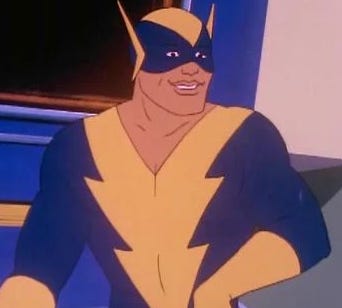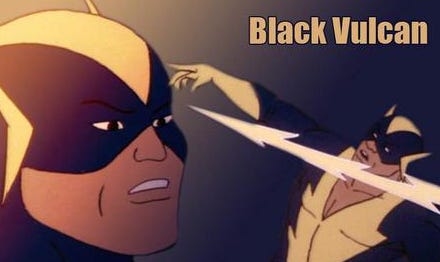"Great Lightning."
This week a look at the superhero that added diversity to the cartoon agenda.
Welcome to Animated, where you can find your weekly dose of cartoon history delivered to your inbox or app.
If you want to write a guest post for my Animated Anecdotes feature, send me a message, and my people can talk to your people :) You can take a look at one here if you’d like.
History
Black Vulcan is a character from the animated series Super Friends, aired in the 1970s and 1980s. The show was produced by Hanna-Barbera and featured a diverse group of superheroes from the DC Comics universe. Black Vulcan was one of the notable members of the Super Friends team, representing a commitment to inclusivity in animated superhero content.
Interestingly, Black Lightning could not be used on the show due to disputes between DC and the creator of Black Lightning, Tony Isabella. This meant that costume model sheets and early storyboards for Black Vulcan were designed by cartoonist Alex Toth, who was responsible for the images of most Hanna-Barbera superheroes during this period.
In the final incarnation of the series, The Super Powers Team: Galactic Guardians, Black Vulcan was replaced by Cyborg, another black superhero who was well-established within the DC Comics brand.
Black Vulcan appears in a few cameos, most notably Scooby-Doo Mask of the Blue and The Lego Batman Movie.
Plotline
The Super Friends series showcased the adventures of a team of superheroes, including iconic characters like Superman, Batman, Wonder Woman, and Aquaman. Black Vulcan joined this group as a powerful hero with control over electricity. His abilities made him a valuable team member, often using his electrical powers to thwart villains and protect the world from various threats.
While Black Vulcan didn't have his solo series, his appearances in Super Friends highlighted the importance of diversity and representation in superhero storytelling. His presence helped broaden the roster of superheroes in the show, promoting inclusivity and offering a positive role model for viewers.
Characters
Black Vulcan: The titular character, Black Vulcan, is an African-American superhero who can manipulate electricity. He uses his powers to generate lightning bolts and control electrical currents, making him a formidable force against villains and adversaries. His catchphrase was, in all comics and animation episodes, “Great Lightning.”
Super Friends Team: Black Vulcan makes up part of the Super Friends. Some heroes, like Superman, Batman, Wonder Woman, and Aquaman, have stood the test of time and are commercial successes today.
Merchandise
While Super Friends generated a range of merchandise, including action figures, comic books, and other related items, specific Black Vulcan merchandise has been limited. The character's presence in the series, however, remains an essential representation of diversity in the world of animated superheroes.
Black Vulcan had several different figures from the Justice League Unlimited tie-in toy line: A 6" Black Vulcan action figure created by Mattel's DC Universe Classics and a Lego mini-figure in Series 2 of the Lego Batman mini-figure line.
Fun Facts
Black Vulcan was created as an original character for the Super Friends show, distinct from the established DC Comics characters. His inclusion was a step towards increasing diversity and representation in animated superhero content.
The character of Black Vulcan was voiced by LeVar Burton, known for his roles in Roots and Star Trek: The Next Generation. Burton's portrayal added depth to the character and contributed to his appeal.
Despite his notable presence in Super Friends, Black Vulcan didn’t receive the same level of exposure as some other superheroes, which has led to discussions among fans about the importance of his character in the context of representation in animated shows.
Black Vulcan remains a significant character in the history of animated superhero series, showcasing the ongoing effort to create more diverse and inclusive narratives.
While Black Vulcan might not have achieved the same recognition as some other superheroes, his contribution to Super Friends represents an important step toward inclusivity, reminding us of the ongoing need for diverse representation in animated storytelling. His appearances in the show continue to serve as a positive example of how superheroes can come from all backgrounds, contributing to a more prosperous and inclusive superhero universe.







This one was wonderful to research. Where culture, society and cartoons overlap.
Indeed. I must admit I like how animations have reflected culture and changed to the changing times. They really have an influence, more than we fully know!